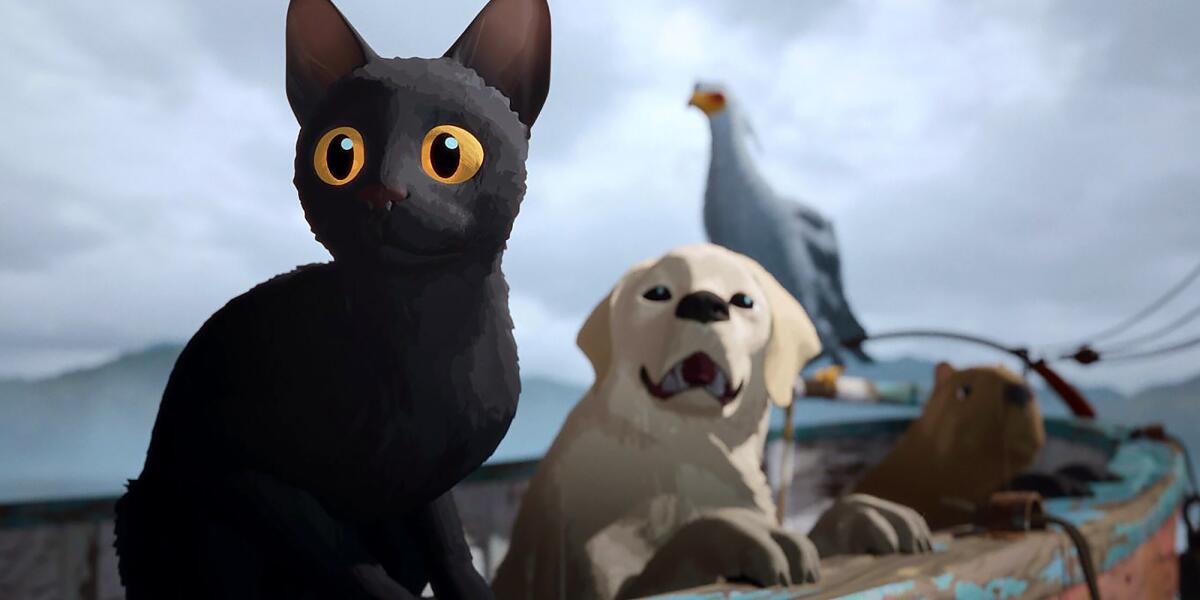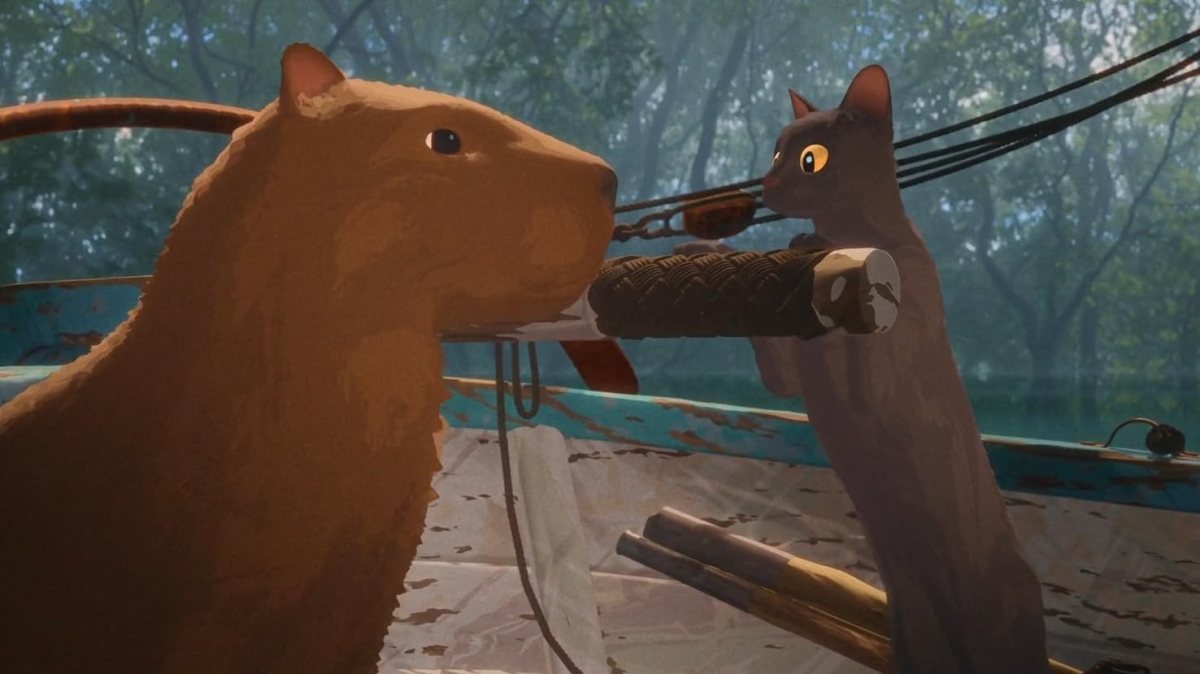For a film about cute animals working together in a beautifully rendered, human-less world, Flow is perhaps the single most stressful experience I had in a cinema in 2024.
Flow opens with a solitary black cat traversing an empty village, where abandoned houses overcome by moss and vines imply a society lost to time not long ago. Typical of its species, the cat seems relatively unfazed by the lack of people there, and has secured a neat little routine of fish-catching, fresh water sourcing and napping in its abode.
The dream is quickly neutered when a tidal wave rudely imposes on the idyllic dell, revealing itself as the source behind the land’s overgrown lushness. This great flood has evidently spread without ceasing for some time – a potential result of a chaotically changing climate. Now displaced among the rapidly rising tide, the little cat must act quickly to survive.
Watch the trailer for Flow:
It didn’t take long before the cat’s cries of distress and its wide-eyed panic forced hot tears to prickle at the corners of my eyes. Not only is Flow‘s combination of Blender-made animation and pre-existing recordings of animal sounds incredibly realistic, but the concept of watching a cat struggle to not drown for 85 minutes really activates my waterworks.
Plus, on the morning I saw Flow, my cat Muta had somehow managed to trap himself in my chest of drawers and pull it down to the ground with him still inside. I know Gints Zilbalodis couldn’t have predicted that when making his now Oscar-winning film, but still – the emotional manipulation felt personal.
ScreenHub: My Melbourne film review: cultures intertwined
As the little cat leaps across the tops of buildings and statues onto floating driftwood and, eventually, a boat, it comes to discover it is not alone in this treacherous journey: there are lemurs, dogs, secretary birds, and a capybara in the same boat (literally).
In an inspired choice, the acquisition of each new member of this motley crew comes with nature-documentary-like challenges – in other words, it’s not all Disneyfied sunshine and rainbows when it comes to different species interacting in a world increasingly stretched for space and resources.
Dogs love to chase cats. Monkeys love to grab things. Birds, particularly of the large prey-driven variety, are more interested in diving for fish than they are in helping out the mammals. And capybaras? Well, they’re actually pretty chill and down for whatever.

Can these wildly different creatures work well enough together to survive the perils of a watery world? You’ll have to hold your breath and see. Let’s just say that once my tears started, they didn’t stop until I had left the theatre. But I promise it was a positive experience!
The coming-together of the central animals of Flow arises from finding common ground: they all need to survive, yes, but, aside from the solitary cat, each of them chooses to leave their established tribes, for reasons that essentially boil down to feeling like strangers among their own kind.
Whether it’s having ambitions beyond what their tribe can provide, or being outright rejected for being injured, the lemur, dog, capybara and secretary bird find a better sense of belonging with each other than they do with their original ‘families’. This found family trope is a classic heartstring-tugger, and it will make you wonder, as it did me, if animals are better at reconciling their differences than we humans are.
With no dialogue in the film (an absolute balm for moviegoers sick to death of the talking animal shtick) Flow instead relies on the expressions and movements of its central characters to tell a story as they navigate the flooded earth.
This is not groundbreaking – as a cinematic convention it’s as old as film itself – but the silent storytelling is masterfully utilised here, as Flow doesn’t ever opt for the anthropomorphic eyebrow-raises we have come to expect from animated features.
The animals are as animal as they come, so their interactions are very subtle, and yet they are burdened with tonnes of emotion.
ScreenHub: Ten Pound Poms Season 2 review: it’s grim down south
Zilbalodis and his team of animators understand innately that as humans, we will infer ways of relating to animals that will ensure our empathy always stays with his central characters. And in terms of narrative stakes, they really couldn’t be higher: every five minutes there is something life-threatening happening to this boatload of buddies, which keeps the viewer hooked in (and my tears unending).
You’re probably familiar by now with the absolute success story this film has been. The animators, who hail primarily from Latvia, Belgium and France, mostly taught themselves to use Blender, the 3D software used to create the world and characters of Flow.
They used their pets at home as references for crafting the look and movements of the animals in the movie, and Zilbalodis, the director, also composed around seven hours of music by himself. Now, after charming festival-goers the world over, they’ve acquired a coveted Academy Award for Best Animated Feature of 2024. And I would say it’s very well deserved.
Flow might make you cry until your eyes are red, but don’t let that put you off. A good cry is a cathartic experience, and that’s what cinema is all about after all. As it receives a general release in Australian cinemas for the first time this Thursday, I highly recommend getting yourself a ticket.
Just make sure you squeeze your pets extra tight after this one.
Flow is in Australian cinemas from 20 March, 2025.
Actors:
Director:
Gints Zilbalodis
Format: Movie
Country: Latvia, Belgium, France
Release: 20 March 2025





